Intel Core i7-11700K Review: Blasting Off with Rocket Lake
by Dr. Ian Cutress on March 5, 2021 4:30 PM EST- Posted in
- CPUs
- Intel
- 14nm
- Xe-LP
- Rocket Lake
- Cypress Cove
- i7-11700K
CPU Tests: Encoding
One of the interesting elements on modern processors is encoding performance. This covers two main areas: encryption/decryption for secure data transfer, and video transcoding from one video format to another.
In the encrypt/decrypt scenario, how data is transferred and by what mechanism is pertinent to on-the-fly encryption of sensitive data - a process by which more modern devices are leaning to for software security.
Video transcoding as a tool to adjust the quality, file size and resolution of a video file has boomed in recent years, such as providing the optimum video for devices before consumption, or for game streamers who are wanting to upload the output from their video camera in real-time. As we move into live 3D video, this task will only get more strenuous, and it turns out that the performance of certain algorithms is a function of the input/output of the content.
HandBrake 1.32: Link
Video transcoding (both encode and decode) is a hot topic in performance metrics as more and more content is being created. First consideration is the standard in which the video is encoded, which can be lossless or lossy, trade performance for file-size, trade quality for file-size, or all of the above can increase encoding rates to help accelerate decoding rates. Alongside Google's favorite codecs, VP9 and AV1, there are others that are prominent: H264, the older codec, is practically everywhere and is designed to be optimized for 1080p video, and HEVC (or H.265) that is aimed to provide the same quality as H264 but at a lower file-size (or better quality for the same size). HEVC is important as 4K is streamed over the air, meaning less bits need to be transferred for the same quality content. There are other codecs coming to market designed for specific use cases all the time.
Handbrake is a favored tool for transcoding, with the later versions using copious amounts of newer APIs to take advantage of co-processors, like GPUs. It is available on Windows via an interface or can be accessed through the command-line, with the latter making our testing easier, with a redirection operator for the console output.
We take the compiled version of this 16-minute YouTube video about Russian CPUs at 1080p30 h264 and convert into three different files: (1) 480p30 ‘Discord’, (2) 720p30 ‘YouTube’, and (3) 4K60 HEVC.
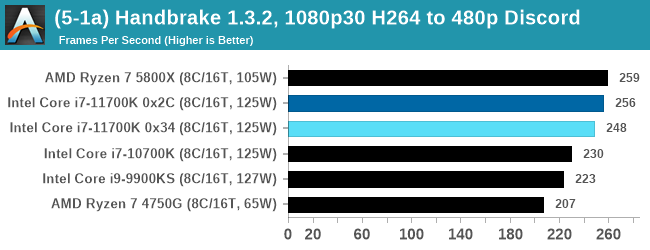
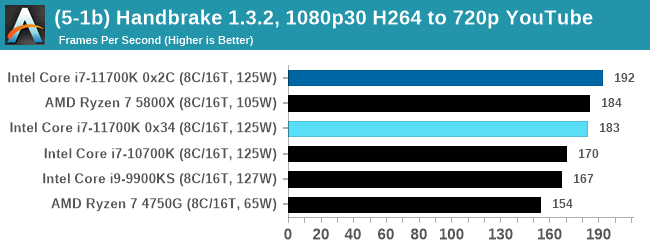
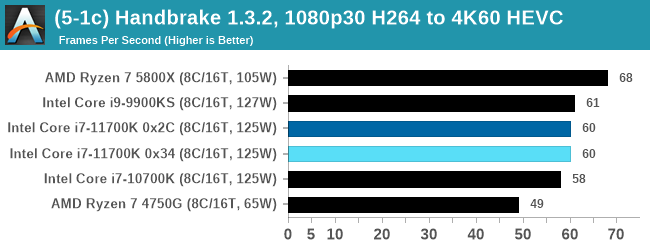
Up to the final 4K60 HEVC, in CPU-only mode, the Intel CPU puts up some good gen-on-gen numbers.
7-Zip 1900: Link
The first compression benchmark tool we use is the open-source 7-zip, which typically offers good scaling across multiple cores. 7-zip is the compression tool most cited by readers as one they would rather see benchmarks on, and the program includes a built-in benchmark tool for both compression and decompression.
The tool can either be run from inside the software or through the command line. We take the latter route as it is easier to automate, obtain results, and put through our process. The command line flags available offer an option for repeated runs, and the output provides the average automatically through the console. We direct this output into a text file and regex the required values for compression, decompression, and a combined score.
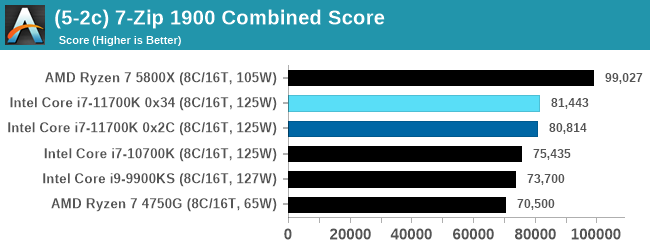
An increase over the previous generation, but AMD has a 25% lead.
AES Encoding
Algorithms using AES coding have spread far and wide as a ubiquitous tool for encryption. Again, this is another CPU limited test, and modern CPUs have special AES pathways to accelerate their performance. We often see scaling in both frequency and cores with this benchmark. We use the latest version of TrueCrypt and run its benchmark mode over 1GB of in-DRAM data. Results shown are the GB/s average of encryption and decryption.
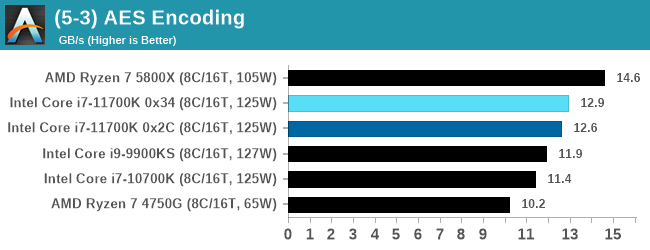
WinRAR 5.90: Link
For the 2020 test suite, we move to the latest version of WinRAR in our compression test. WinRAR in some quarters is more user friendly that 7-Zip, hence its inclusion. Rather than use a benchmark mode as we did with 7-Zip, here we take a set of files representative of a generic stack
- 33 video files , each 30 seconds, in 1.37 GB,
- 2834 smaller website files in 370 folders in 150 MB,
- 100 Beat Saber music tracks and input files, for 451 MB
This is a mixture of compressible and incompressible formats. The results shown are the time taken to encode the file. Due to DRAM caching, we run the test for 20 minutes times and take the average of the last five runs when the benchmark is in a steady state.
For automation, we use AHK’s internal timing tools from initiating the workload until the window closes signifying the end. This means the results are contained within AHK, with an average of the last 5 results being easy enough to calculate.
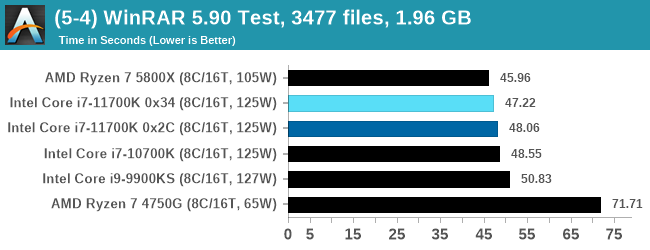
CPU Tests: Legacy and Web
In order to gather data to compare with older benchmarks, we are still keeping a number of tests under our ‘legacy’ section. This includes all the former major versions of CineBench (R15, R11.5, R10) as well as x264 HD 3.0 and the first very naïve version of 3DPM v2.1. We won’t be transferring the data over from the old testing into Bench, otherwise it would be populated with 200 CPUs with only one data point, so it will fill up as we test more CPUs like the others.
The other section here is our web tests.
Web Tests: Kraken, Octane, and Speedometer
Benchmarking using web tools is always a bit difficult. Browsers change almost daily, and the way the web is used changes even quicker. While there is some scope for advanced computational based benchmarks, most users care about responsiveness, which requires a strong back-end to work quickly to provide on the front-end. The benchmarks we chose for our web tests are essentially industry standards – at least once upon a time.
It should be noted that for each test, the browser is closed and re-opened a new with a fresh cache. We use a fixed Chromium version for our tests with the update capabilities removed to ensure consistency.
Mozilla Kraken 1.1
Kraken is a 2010 benchmark from Mozilla and does a series of JavaScript tests. These tests are a little more involved than previous tests, looking at artificial intelligence, audio manipulation, image manipulation, json parsing, and cryptographic functions. The benchmark starts with an initial download of data for the audio and imaging, and then runs through 10 times giving a timed result.
We loop through the 10-run test four times (so that’s a total of 40 runs), and average the four end-results. The result is given as time to complete the test, and we’re reaching a slow asymptotic limit with regards the highest IPC processors.
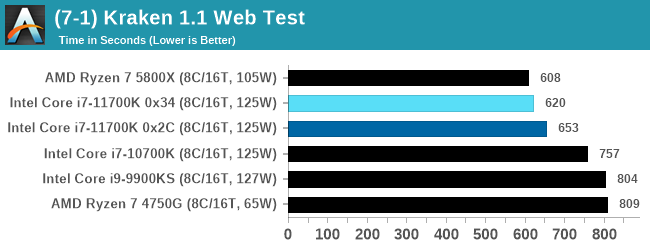
Google Octane 2.0
Our second test is also JavaScript based, but uses a lot more variation of newer JS techniques, such as object-oriented programming, kernel simulation, object creation/destruction, garbage collection, array manipulations, compiler latency and code execution.
Octane was developed after the discontinuation of other tests, with the goal of being more web-like than previous tests. It has been a popular benchmark, making it an obvious target for optimizations in the JavaScript engines. Ultimately it was retired in early 2017 due to this, although it is still widely used as a tool to determine general CPU performance in a number of web tasks.
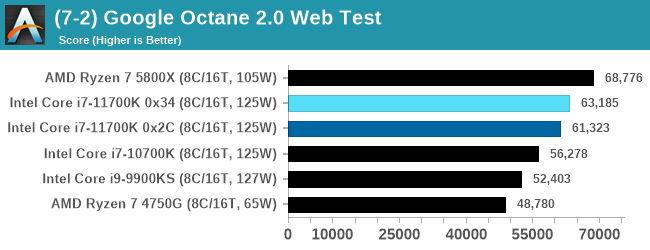
Speedometer 2: JavaScript Frameworks
Our newest web test is Speedometer 2, which is a test over a series of JavaScript frameworks to do three simple things: built a list, enable each item in the list, and remove the list. All the frameworks implement the same visual cues, but obviously apply them from different coding angles.
Our test goes through the list of frameworks, and produces a final score indicative of ‘rpm’, one of the benchmarks internal metrics.
We repeat over the benchmark for a dozen loops, taking the average of the last five.
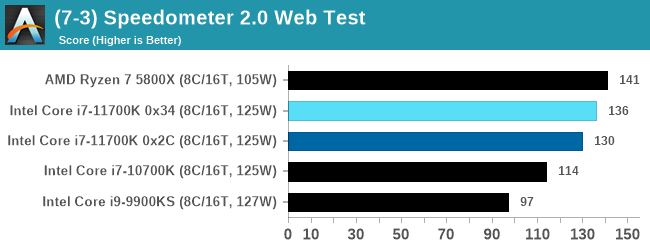
Legacy Tests
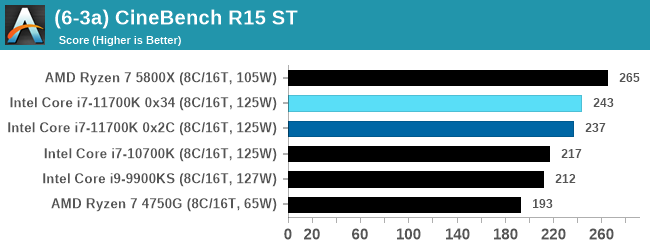
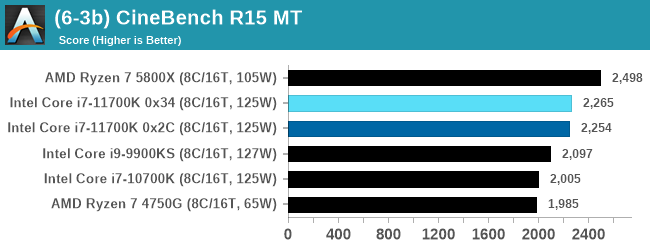
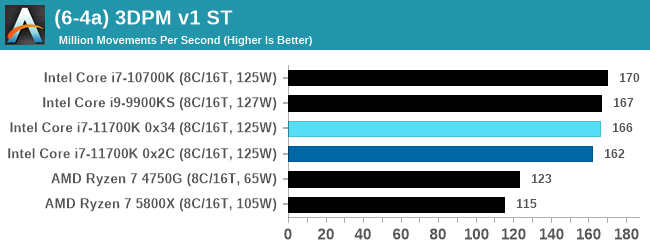
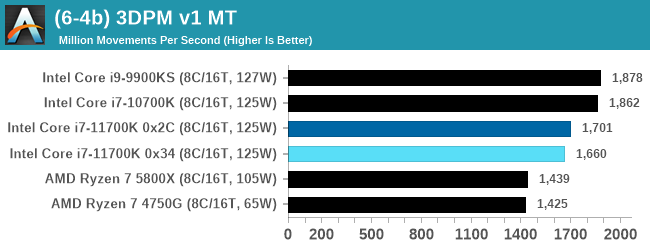


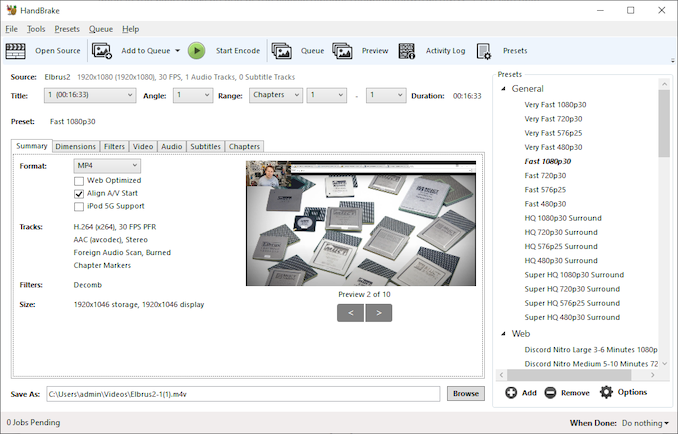
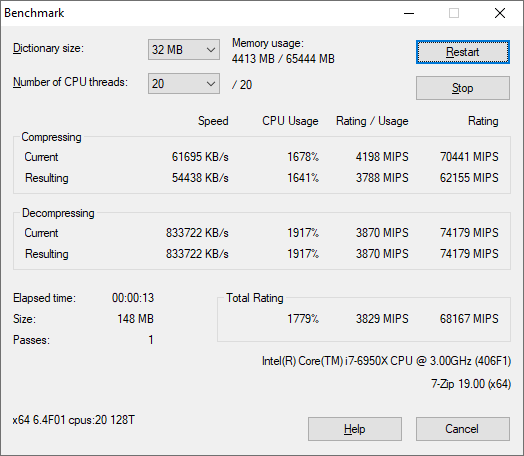
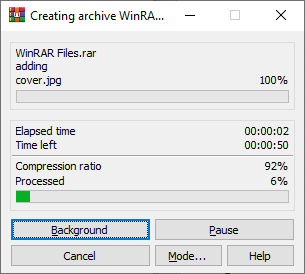

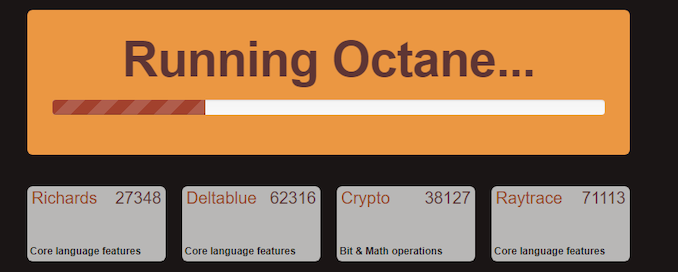
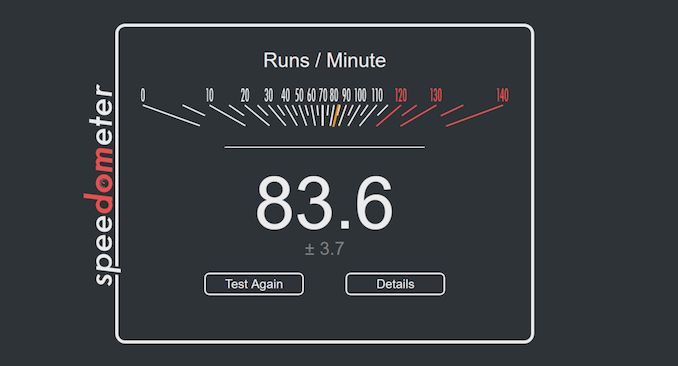








541 Comments
View All Comments
brucethemoose - Monday, March 8, 2021 - link
1: AT benches on Windows, and right now x86 vs ARM is kinda Apples-to-oranges on that platform, especially when one starts mixing in emulation and AVX.Give it time. More comparisons will come. But you'll probably see comparisons on Linux/Mac, and open source software in general, sooner.
2: People uses CPUs for different things. Some of these benches are relevant to those people.
At the same time, my use cases weren't really covered here, so... I get what you're saying.
3. Yeah, it seems rather silly to me, especially when Anand test GPU limited AAA games.
Where you really need a big CPU is in simulation/sandbox games, especially in servers for such things, and sluggish early access stuff. But no one ever benches those :/
Silver5urfer - Monday, March 8, 2021 - link
So with the 19% IPC claim and losing to 9900KS and 10700K what is the point of releasing this chip, from Intel. I never got much from AT benches a lot and preferred the Hardware unboxed, Gamernexus guys and others. But if this is the final performance figures, then this is really a DOA product from Intel. How can they allow this ? I never saw Intel in such a position..maybe X299 got rekted when Zen 2 dropped but this is mainstream segment.Damn it. AMD processors have the idiotic stock related issues, add that WHEA and USB shitstorm. Intel has bullshit performance over past gen except a Gen4 addition and extra lanes from chipset. GPUs are out of damn stock as well.
2020 and 2021 both are completely fucked up for PC HW purchases.
Gigaplex - Monday, March 8, 2021 - link
"I never saw Intel in such a position.."The Pentium 4, in particular the Prescott architecture was a dud back in the early 2000's. That era spawned the antitrust lawsuit against Intel for illegally blocking AMD sales since the Intel products weren't competitive.
dwbogardus - Monday, March 8, 2021 - link
The fact that Intel can even remain in a close second place, using a 14 nm process is impressive. Imagine what they could do with TSMC's 7 nm process! It would almost certainly outperform AMD by a significant margin.Bagheera - Monday, March 8, 2021 - link
Really tired of Intel fanboys saying this.architectures are designed for specific nodes - RKL's problems are exactly due to porting an arch onto a node it wasn't designed for.
the fact is Intel is not a partner for TSMC and their archs are not designed for TSMC processes. if Intel were to outsource CPU production to TSMC, they will either have to make a new arch or make make tweaks to existing ones - a multi-million $ endeavor with risms of issues like your just read with RKL.
Hifihedgehog - Tuesday, March 9, 2021 - link
> a close second place^Here we see in his natural environment your common everyday dude who fails at reading comprehension. I guess you didn't read the part about the serious gaming performance losses and latency regressions gen-over-gen, the 10% performance gap in single-threaded or 10-20%+ performance gaps in multithread, or the inexcusably high peak power draw? Talk about deluded...
RanFodar - Monday, March 8, 2021 - link
Though their efforts may be futile, I am glad Intel attempted to do something out of the ordinary; not a Skylake refresh, but a backport that is found to have worse performance. And yet, it is an attempt for Intel to learn their lessons for generations to come.Hifihedgehog - Tuesday, March 9, 2021 - link
Backporting is not a lesson; it is a last ditch effort or a fallback when all else fails on the manufacturing side. Half full, half empty cup viewing aside, they wasted even more valuable engineering manhours into a failed backport when it should have been invested into developing new architectures. A best use would have been developing the next release. The problem is Intel had to make Rocket Lake good enough in synthetic benchmarks to appease their investors. That, however, still does not address the elephants in the room of 10-20% single threaded performance gaps or—the one that takes the cake—the latency regressions that makes gaming worse, Intel’s historic crown jewel. Much like movies that fail at release and live on box office bombs that their producers later opine should have been cut early on in development, Intel should have cut this idea early on. If you are looking for a lesson that Intel should have learned here, there it is: avoid another Rocket Lake backporting disaster and just warm over your current microarchitecture with one more middling refresh one last time.Hifihedgehog - Tuesday, March 9, 2021 - link
Ian, I just want to say thank you for the incredible review. Just ignore the haters on social media and in the comments who get their panties in a bunch. If the product is garbage, say it like it is, like you did and quite well I might add. You were incredibly diplomatic about it and even openly and honestly showed when and where Intel did win on the rare occasion in the benchmarks. It is so silly how people make these CPU companies (who don't know them from Sam Hill) their religion, as if erecting a Gordon Moore or Lisa Su shrine would avail them anything. Silly geese.misiu_mp - Wednesday, March 10, 2021 - link
Is that the new bulldozer?